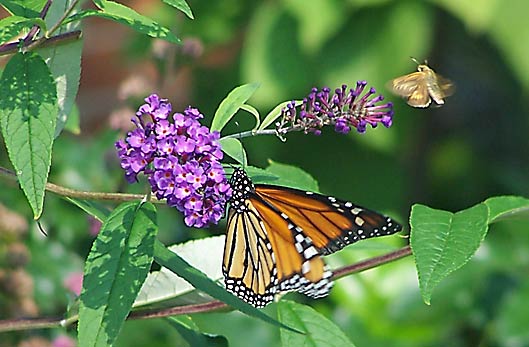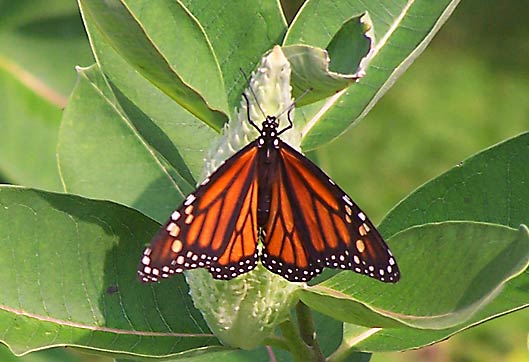 Photographs by Sandie Parrott
Photographs by Sandie Parrott
A monarch butterfly and sphinx moth on ‘Black Knight’ butterfly bush.Natives for butterfly host plants and caterpillar food
To provide places for butterflies to lay eggs as well as food for the emerging caterpillars, choose butterfly host plants. And remember that the caterpillars will be doing some major eating on your host plants—it’s part of the process!
| Common name | Botanical name | Butterflies attracted |
| Aster | Aster | Pearl crescent |
| Cherry | Prunus | Red-spotted purple, tiger swallowtail, spring azure |
| Dogwood | Cornus | Spring azure |
| Elm | Ulmus americana | Comma, question mark, mourning cloak |
| False nettle | Boehmeria cylindrica | Red admiral, question mark, comma, Milbert’s tortoiseshell |
| Grasses, sedges | various | Alfalfa sulphur, Eastern tailed-blue |
| Hackberry | Celtis occidentalis | Question mark, comma, hackberry butterfly, tawny emperor, mourning cloak |
| Highbush blueberry | Vaccinium corymbosum | Brown elfin |
| Leadplant | Amorpha canescens | Dogface, silver-spotted skipper |
| Milkweed | Asclepias | Monarch, queen |
| Nettle | Urtica dioica | Red admiral, question mark, comma, Milbert’s tortoiseshell |
| Oak | Quercus | Banded hairstreak |
| Paw Paw | Asimina triloba | Zebra swallowtail |
| Sneezeweed | Helenium autumnale | Dainty sulphur |
| Spicebush | Lindera benzoin | Spicebush swallowtail, tiger swallowtail |
| Sundial lupine | Lupinus perennis | Karner blue, silvery blue |
| Swamp thistle | Cirsium muticum | Painted lady |
| Turtlehead | Chelone glabra | Baltimore, buckeye |
| Vetch | Vicia | Alfalfa sulphur, Eastern tailed-blue |
| Violet | Viola | Great spangled fritillary, meadow fritillary |
| Willow | Salix | Viceroy, mourning cloak |
Nectar-producing plants for butterfly food
To encourage butterflies to continually visit your garden, choose a variety of nectar-producing plants (for butterfly food) that produce blooming flowers throughout the season. Butterflies are most active in mid to late summer, so make sure you have plenty of flowers in bloom at that time.
| Common name | Botanical name | |
| Spring | Black-eyed Susan | Rudbeckia hirta |
| Columbine | Aquilegia canadensis | |
| Nodding wild onion | Allium cernuum | |
| Spicebush | Lindera benzoin | |
| Wild geranium | Geranium maculatum | |
| Midsummer | Bee balm | Monarda didyma |
| Bergamot | Monarda fistulosa | |
| Black-eyed Susan | Rudbeckia hirta | |
| Blazing star, dense | Liatris spicata | |
| Blazing star, rough | Liatris aspera | |
| Butterfly weed | Asclepias tuberosa | |
| Buttonbush | Cephalanthus occidentalis | |
| Coreopsis, tall | Coreopsis tripteris | |
| Dogbane | Apocynum | |
| Fleabane | Erigeron | |
| Horsemint | Monarda punctata | |
| Meadowsweet | Spiraea alba | |
| Michigan lily | Lilium michiganense | |
| Milkweed, common | Asclepias syriaca | |
| Milkweed, swamp | Asclepias incarnata | |
| New Jersey tea | Ceanothus americanus | |
| Pearly everlasting | Anaphalis margaritacea | |
| Sunflower, giant | Helianthus giganteus | |
| Swamp thistle | Cirsium muticum | |
| Virginia mountain mint | Pycnanthemum virginianum | |
| Yarrow | Achillea millefolium | |
| Late summer | Aster, flat-topped | Aster umbellatus |
| Aster, heath | Aster ericoides | |
| Aster, smooth | Aster laevis | |
| Aster, New England | Aster novae-angliae | |
| Beggarticks | Bidens aristosa | |
| Boneset | Eupatorium perfoliatum | |
| Goldenrod, Ohio | Solidago ohioensis | |
| Goldenrod, rigid | Solidago rigida | |
| Goldenrod, showy | Solidago speciosa | |
| Ironweed, tall | Vernonia gigantea | |
| Joe-Pye weed | Eupatorium maculatum | |
| Sneezeweed | Helenium autumnale | |
| Steeplebush | Spiraea tomentosa |
Charts courtesy of Suzan Campbell, Conservation Associate, Michigan Natural Features Inventory, and formerly from the Belle Isle Nature Center
 Milkweed is a nectar source for many butterflies and hummingbirds as well as a larval food for monarchs (the caterpillars only eat milkweed).
Milkweed is a nectar source for many butterflies and hummingbirds as well as a larval food for monarchs (the caterpillars only eat milkweed).

Leave a Reply